Alexx V arrive in NJ
- Thread starter marty
- Start date
You are using an out of date browser. It may not display this or other websites correctly.
You should upgrade or use an alternative browser.
You should upgrade or use an alternative browser.
Congratulations Marty. Your enthusiasm for the new arm comes through very clearly. It seems like a technological marvel. Are there not two different weed linear tracking arms? Or maybe I am thinking of a da Vinci. Thank you for sharing this story. I look forward to reading more about your listening impressions.
Now that's a funny typo!Are there not two different weed linear tracking arms?
But yes, Reed makes 2 versions (5T and 5A) that utilize the same principle.
Now that's a funny typo!
But yes, Reed makes 2 versions (5T and 5A) that utilize the same principle.
Sorry Marty. I often simply dictate into my phone. Ron was considering a Reed linear tracking arm and he described one as more complicated than the other as I recall. Perhaps the difference was the laser I can’t remember or the motor.
Thanks for great write up Marty.
This is just the start. At some point you can have the Thales statement installed too on the Dohmann. Then replace the least favourite one with Schroeder LT with the help of either OMA or Steve Dobbins.
So once you have your favourite pivoted LT on the Dohmann, you can ask Bob to drive over with a Vyger and leave it there for a few days. And since all that might be a couple of years away, Mike might be ready to move on from his CS port table to something else so you might get a good deal.
then with all the linear tracking itch scratched you can peacefully sit back and listen to your digital
This is just the start. At some point you can have the Thales statement installed too on the Dohmann. Then replace the least favourite one with Schroeder LT with the help of either OMA or Steve Dobbins.
So once you have your favourite pivoted LT on the Dohmann, you can ask Bob to drive over with a Vyger and leave it there for a few days. And since all that might be a couple of years away, Mike might be ready to move on from his CS port table to something else so you might get a good deal.
then with all the linear tracking itch scratched you can peacefully sit back and listen to your digital
Sorry Marty. I often simply dictate into my phone. Ron was considering a Reed linear tracking arm and he described one as more complicated than the other as I recall. Perhaps the difference was the laser I can’t remember or the motor.
The Reed 5T is the tonearm I fell in love with at audioquattr’s and reported on several years ago.
That's the one made in The Netherlands ;-) and sold in Colorado......Now that's a funny typo!
But yes, Reed makes 2 versions (5T and 5A) that utilize the same principle.
I've setup a few 5T's now and absolutely love the sonic picture they paint. In one setup on Helix 1 a Koetsu Blue Lace Platinum and Coralstone Platinum provided OMG moments across a very broad musical spectrum. Its the unforced nature that really appeals and removes another element of compressive artifact we struggle with in analog replay.
I urged Marty to persist in the setup. It was like a jungle explorer having to cut through dense foliage to finally arrive at the edge of a beautiful valley. The nicks cuts and scratches to beat the path there will heal quickly.
Welcome to paradise.....now where is that copy of Spirit of Eden?.....................................
Hi Marty, how are you? I have recently joined WBF and come across your post. A belated congratulations to your Wilson Audio Alexx V speaker !
I have also installed the Alexx V very recently in Sept 2022. This is my first large speaker ever owned and it's only at early stage of breaking in the speaker, and probably will take a while to set it up properly. However, initial impression is very good indeed.
Cheers,
Simcity.
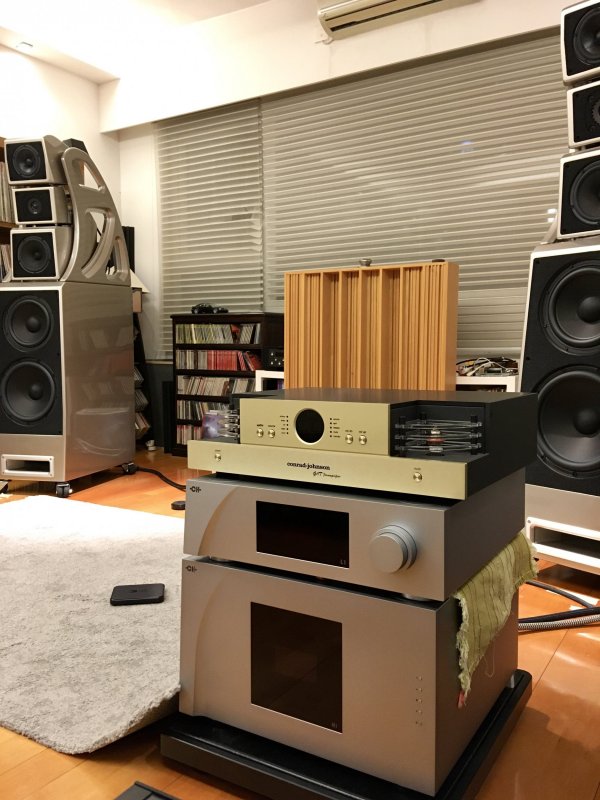
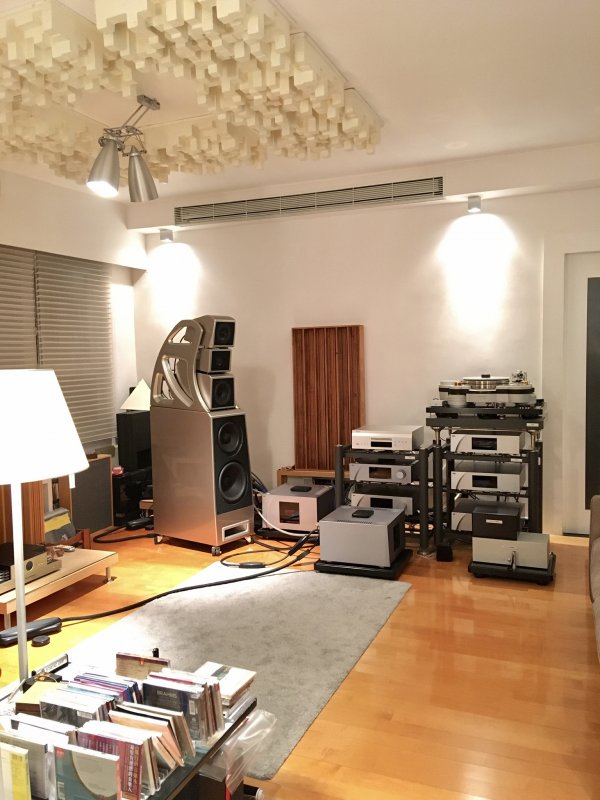
I have also installed the Alexx V very recently in Sept 2022. This is my first large speaker ever owned and it's only at early stage of breaking in the speaker, and probably will take a while to set it up properly. However, initial impression is very good indeed.
Cheers,
Simcity.


Last edited:
Congrats! What a great speaker by all accounts...big fan of your CJ GAT 2 (was a 20+ year consecutive owner of CJ preamps from CJPV14L to ACT 2, CJ GAT 1, CJ GAT 2...so grainless, extended and natural. Imagine you spent a lot of time debating whether to go another SS amp, CJ reference amp (apparently the latest ones are phenomenal)...what led you to CH?
Congrats! What a great speaker by all accounts...big fan of your CJ GAT 2 (was a 20+ year consecutive owner of CJ preamps from CJPV14L to ACT 2, CJ GAT 1, CJ GAT 2...so grainless, extended and natural. Imagine you spent a lot of time debating whether to go another SS amp, CJ reference amp (apparently the latest ones are phenomenal)...what led you to CH?
Thank you so much, ctydwn, marty, bryans, abeidrov, MadFloyd, ashandger, StreamFidelity, XV-1 & christoph !!Dear LL21, thanks a lot!! It's almost 2 months since the delivery of the Wilson Audio Alexx V speaker and the initial excitement has started to calm down now. It's really an overwhelming experience for me since I could never imagine owing such a "huge" speaker in my life. Anyway, I am a big fan of the conrad johnson gears, having owned some of their pre & power amps for the past 20 years (premier 16, 17, Act2, Gat2, 350, 12 mono etc). cj gears are sort of more affordable to me and overall providing very good performance and musicality, and I always prefer a wireless remoteCongrats! What a great speaker by all accounts...big fan of your CJ GAT 2 (was a 20+ year consecutive owner of CJ preamps from CJPV14L to ACT 2, CJ GAT 1, CJ GAT 2...so grainless, extended and natural. Imagine you spent a lot of time debating whether to go another SS amp, CJ reference amp (apparently the latest ones are phenomenal)...what led you to CH?
WOW LL21, you have the Robert Koda K15EX Super Ground !!!!! I have auditioned in two separate occasions during my home visits previously and it must be one of the best preamps ever produced despite the huge cost. I just couldn't believe my ears when auditioned to this gear. So once again congratulations LL21, what a lucky guy you are !!!!!
Simcity
Wow...you are a much bigger CJ audiophile than I am...and I have been a proud owner of CJ preamps for over 20 years consecutively. Unfortunately, on the amplification-side, I never got past the MV60 60-watt amp (which was a very special EL34 amp)...nearly got the Premier 350 and thought about upgrading an old pair of Premier 8s, but did not. Impressive on your part! And yes, entirely agree with you on CJ...they really and truly have lived up to a hard-working, down-to-earth design ethic of purity, no grain and natural music...expensive but genuine long-term value.Dear LL21, thanks a lot!! It's almost 2 months since the delivery of the Wilson Audio Alexx V speaker and the initial excitement has started to calm down now. It's really an overwhelming experience for me since I could never imagine owing such a "huge" speaker in my life. Anyway, I am a big fan of the conrad johnson gears, having owned some of their pre & power amps for the past 20 years (premier 16, 17, Act2, Gat2, 350, 12 mono etc). cj gears are sort of more affordable to me and overall providing very good performance and musicality, and I always prefer a wireless remoteI still has the Act2, Gat2 and 350 at home right now.
WOW LL21, you have the Robert Koda K15EX Super Ground !!!!! I have auditioned in two separate occasions during my home visits previously and it must be one of the best preamps ever produced despite the huge cost. I just couldn't believe my ears when auditioned to this gear. So once again congratulations LL21, what a lucky guy you are !!!!!
Simcity
As for Robert Koda, it is always interesting to hear from people who have heard it...and who have an ear I can 'sort of calibrate' given your deep understanding of CJ. I have no ego about the system...simply blessed to enjoy what I enjoy. Nevertheless, I learn from those who have heard equipment we own both pros and cons.
Look forward to reading more as you get to know your amazing Alexx V. Enjoy!
Zanden Phono Stage “time constant” implementation- have we really heard our vinyl before?
We are all keenly aware that the past two years have seen what many consider significant advancements in the area of digital music reproduction with the release of several landmark products such as the Taiko Extreme server and software, the Lampizator Horizon DAC, the Wadax server and DAC, and other significant offerings from MSB, Total DAC and several others. User impressions are pretty much unanimous. Digital continues to improve and delivers SQ well beyond what we could only imagine a few short years ago. The phrase uttered around the world is “the gap is closing”, which has been a mantra of audiophiles for generations when comparing the SQ we get at home compared to live music. Even if you use the analogy that we continue to get closer to a doorway we can never get through, we enjoy our incremental improvements and often consider them revelations. For quite a few years, these improvements seem to be more prevalent and noteworthy in the digital space. While the advancements on the vinyl side includes better turntables, arms and cartridges, the basics of the electronic circuitry that processes the amplification of miniscule voltage signals that amplify moving coil or moving magnet cartridges so that they are suitable for further processing downstream have not really changed much over the past 40 years or so since the RIAA was “standardized” as the basis of the EQ correction necessary for these phono devices to function well. Until now.
Kazutoshi Yamada, the CEO and Chief Brain Officer who runs Zanden Audio Systems in Osaka, Japan released his 1200 Phono stage 17 years ago. Universally applauded, Yamada-san has now implemented a major design upgrade which he believes achieves the designer’s ultimate goal of perfect reproduction in vinyl replay. His latest is the Model 1200 Signature which is the culmination of continued improvements made in the Model 1200 series over its long history. It is a fully balanced LCR type phono pre-amplifier with Zanden’s unique 15 types of equalization curve switching, heretofore unseen in the audio world. A part of his latest advancements such as various EQ curves, were already seen in the earlier 1200 Mk3 (single ended only) which I own. But recently, I sent my phono stage back to Japan for an upgrade that incorporates many of the main advancements of the 1200 Signature (which differs from my unit by offering balanced as well as single-ended outputs). The modification to my 1200 Mk3 is now called the 1200 Mk4. According to Yamada-san, “the hearing experience is comparable to listening to a master tape and makes one forget that the source is a vinyl disc”. So what is the magic that Yamada-san incorporated to take vinyl reproduction to the next level?
The essence of his new technology is the incorporation of circuitry that corrects for the “4th time constant”. While this term suggests some sort of wacko phenomenon involving the space time continuum, in reality it is newly implemented circuity that Zanden now incorporates to allow for the full recovery of information that is embedded in the LP cutting machine which has never been previously available for the several EQ curves typically employed by the major LP manufacturers. Zanden believes that high-end audiophiles must have this functionality if their ultimate goal is to achieve high fidelity in sound reproduction in order to listen to the exact original recording of the LP when it was cut.
What exactly does the the 4th t/c circuity do? To begin, it effects both the amplitude of the frequency response used in the every EQ curve that the Zanden phono stage employs (RIAA plus 4 more) as shown here
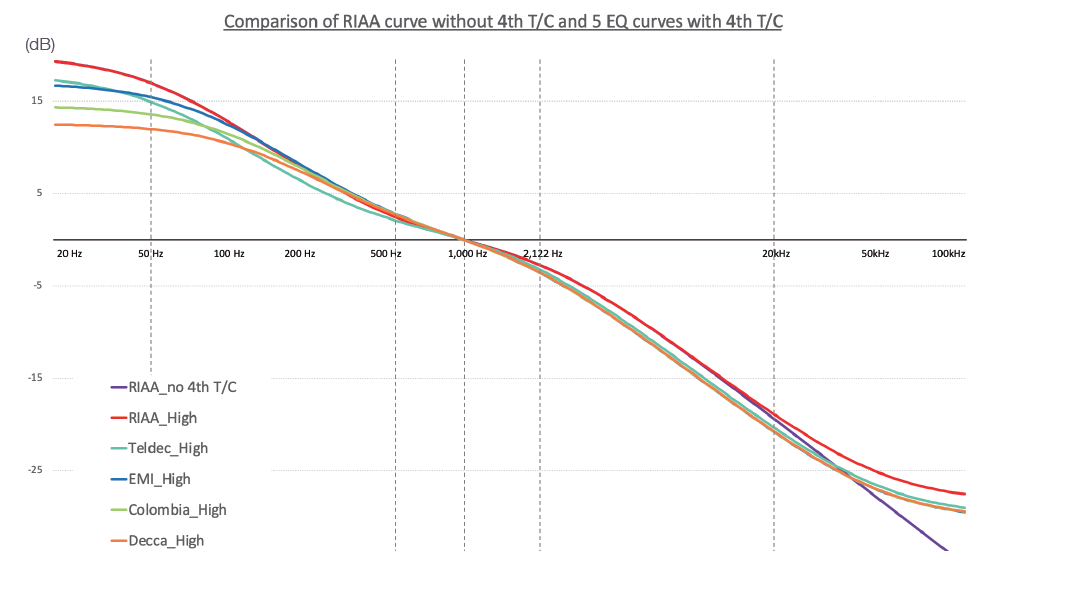
Shown another way, here are the difference of the EQ curves with high t/c correction versus the RIAA curve with and without t/c correction.
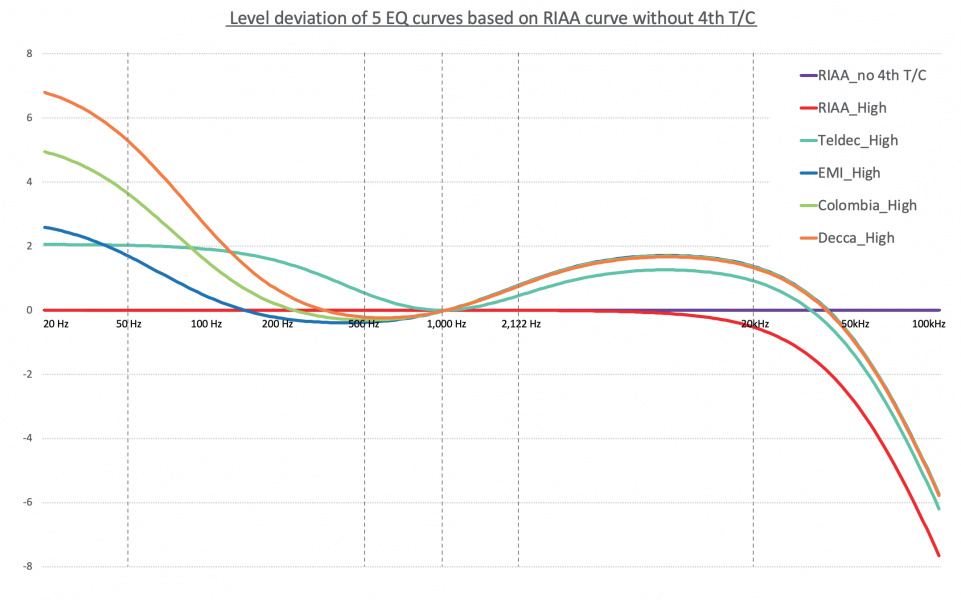
While some of these changes are minimal among curves, others are certainly significant.
To be continued
We are all keenly aware that the past two years have seen what many consider significant advancements in the area of digital music reproduction with the release of several landmark products such as the Taiko Extreme server and software, the Lampizator Horizon DAC, the Wadax server and DAC, and other significant offerings from MSB, Total DAC and several others. User impressions are pretty much unanimous. Digital continues to improve and delivers SQ well beyond what we could only imagine a few short years ago. The phrase uttered around the world is “the gap is closing”, which has been a mantra of audiophiles for generations when comparing the SQ we get at home compared to live music. Even if you use the analogy that we continue to get closer to a doorway we can never get through, we enjoy our incremental improvements and often consider them revelations. For quite a few years, these improvements seem to be more prevalent and noteworthy in the digital space. While the advancements on the vinyl side includes better turntables, arms and cartridges, the basics of the electronic circuitry that processes the amplification of miniscule voltage signals that amplify moving coil or moving magnet cartridges so that they are suitable for further processing downstream have not really changed much over the past 40 years or so since the RIAA was “standardized” as the basis of the EQ correction necessary for these phono devices to function well. Until now.
Kazutoshi Yamada, the CEO and Chief Brain Officer who runs Zanden Audio Systems in Osaka, Japan released his 1200 Phono stage 17 years ago. Universally applauded, Yamada-san has now implemented a major design upgrade which he believes achieves the designer’s ultimate goal of perfect reproduction in vinyl replay. His latest is the Model 1200 Signature which is the culmination of continued improvements made in the Model 1200 series over its long history. It is a fully balanced LCR type phono pre-amplifier with Zanden’s unique 15 types of equalization curve switching, heretofore unseen in the audio world. A part of his latest advancements such as various EQ curves, were already seen in the earlier 1200 Mk3 (single ended only) which I own. But recently, I sent my phono stage back to Japan for an upgrade that incorporates many of the main advancements of the 1200 Signature (which differs from my unit by offering balanced as well as single-ended outputs). The modification to my 1200 Mk3 is now called the 1200 Mk4. According to Yamada-san, “the hearing experience is comparable to listening to a master tape and makes one forget that the source is a vinyl disc”. So what is the magic that Yamada-san incorporated to take vinyl reproduction to the next level?
The essence of his new technology is the incorporation of circuitry that corrects for the “4th time constant”. While this term suggests some sort of wacko phenomenon involving the space time continuum, in reality it is newly implemented circuity that Zanden now incorporates to allow for the full recovery of information that is embedded in the LP cutting machine which has never been previously available for the several EQ curves typically employed by the major LP manufacturers. Zanden believes that high-end audiophiles must have this functionality if their ultimate goal is to achieve high fidelity in sound reproduction in order to listen to the exact original recording of the LP when it was cut.
What exactly does the the 4th t/c circuity do? To begin, it effects both the amplitude of the frequency response used in the every EQ curve that the Zanden phono stage employs (RIAA plus 4 more) as shown here

Shown another way, here are the difference of the EQ curves with high t/c correction versus the RIAA curve with and without t/c correction.

While some of these changes are minimal among curves, others are certainly significant.
To be continued
Last edited:
Although these amplitude changes are important, the other aspect of the 4th t/c circuit changes are those on phase response, which one can easily appreciate may render significant sonic signature changes.
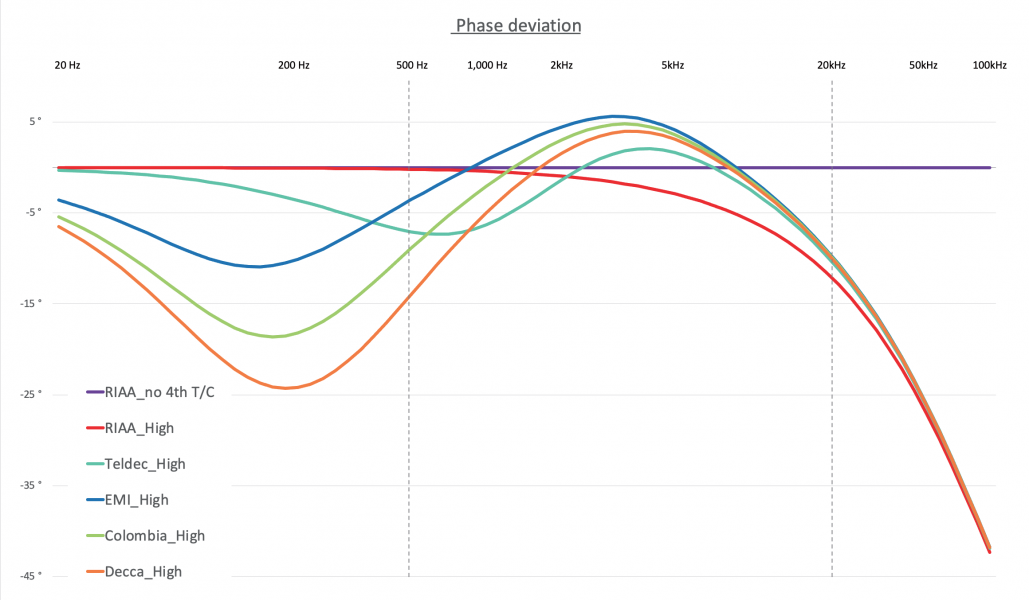
Just take a look at some of these deviations in the corrected 4th t/c curves among these manufacturers, not to mention the std RIAA curve with and without 4th t/c correction. Taken together, these changes in both amplitude and phase result in profound listening effects. While changes in amplitude may in some instances be thought of nothing more than a “tone control”, which it certainly is, I think the changes in phase response provide something far more than what a traditional tone control can offer and therefore sets the Xanden circuity apart from anything that has preceded it. According to Zanden, the accuracy of the equalization in the high frequency region (to about 40k Hz ), which is affected by the 4th t/c, has a great influence on sound reproduction and reverberation in the recording venue, that is, the realism of the performance, the atmosphere and physical size/dimension of the venue.
Again, from Zanden:
“As you know, the role of the phono preamplifier is to apply the equalization curve to the audio signal, which is the opposite of the one applied when the record is made on the cutting lathe, and then restore the audio signal carved in the disc to the same state at the time of sound recording. In other words, when considering equalization with a phono preamplifier, it is essential to think about equalization during cutting vinyl discs and accurately reproduce the opposite equalization curve. Considering that point, it is natural that the 4th t/c is set and equalized so that the input above a certain frequency is suppressed in order to protect the cutter head from wear and tear during vinyl disc cutting. It also makes sense to set the different frequency value for the 4th t/c depending on the type of cutting head or cutting amplifier being used.”
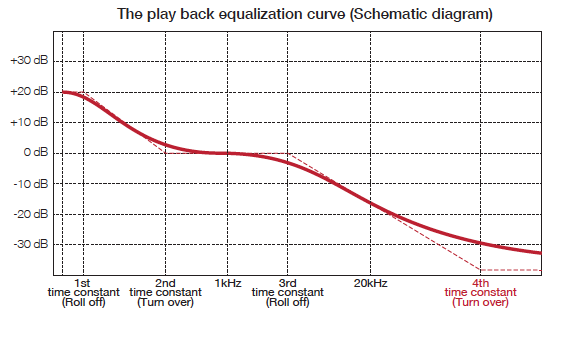
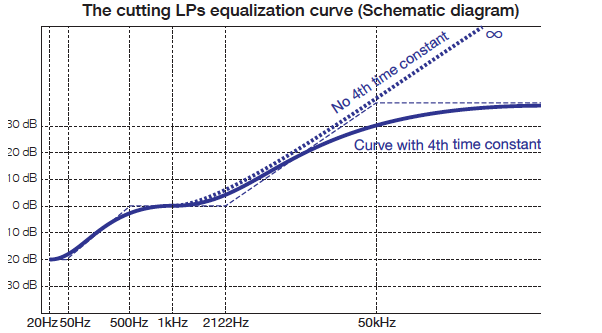
Based on this, one can understand why every Zanden phono stage that incorporates the correction for the 4th t/c includes a comprehensive 16 page manual that lists the appropriate settings for phase selection, manufacturer EQ curves, and t/c correction (high, medium and low) for every known record label.
"Once you listen to your precious LP collection with the appropriate EQ curve and the correct t/c setting, you can instantly hear the vast improvement and say to yourself in amazement, “this is beyond the best sound I could ever imagine!”
I guess you can't condemn a manufacturer for using at bit of hyberbole, but if there's some truth to it, well......
to be continued

Just take a look at some of these deviations in the corrected 4th t/c curves among these manufacturers, not to mention the std RIAA curve with and without 4th t/c correction. Taken together, these changes in both amplitude and phase result in profound listening effects. While changes in amplitude may in some instances be thought of nothing more than a “tone control”, which it certainly is, I think the changes in phase response provide something far more than what a traditional tone control can offer and therefore sets the Xanden circuity apart from anything that has preceded it. According to Zanden, the accuracy of the equalization in the high frequency region (to about 40k Hz ), which is affected by the 4th t/c, has a great influence on sound reproduction and reverberation in the recording venue, that is, the realism of the performance, the atmosphere and physical size/dimension of the venue.
Again, from Zanden:
“As you know, the role of the phono preamplifier is to apply the equalization curve to the audio signal, which is the opposite of the one applied when the record is made on the cutting lathe, and then restore the audio signal carved in the disc to the same state at the time of sound recording. In other words, when considering equalization with a phono preamplifier, it is essential to think about equalization during cutting vinyl discs and accurately reproduce the opposite equalization curve. Considering that point, it is natural that the 4th t/c is set and equalized so that the input above a certain frequency is suppressed in order to protect the cutter head from wear and tear during vinyl disc cutting. It also makes sense to set the different frequency value for the 4th t/c depending on the type of cutting head or cutting amplifier being used.”


Based on this, one can understand why every Zanden phono stage that incorporates the correction for the 4th t/c includes a comprehensive 16 page manual that lists the appropriate settings for phase selection, manufacturer EQ curves, and t/c correction (high, medium and low) for every known record label.
"Once you listen to your precious LP collection with the appropriate EQ curve and the correct t/c setting, you can instantly hear the vast improvement and say to yourself in amazement, “this is beyond the best sound I could ever imagine!”
I guess you can't condemn a manufacturer for using at bit of hyberbole, but if there's some truth to it, well......
to be continued
Last edited:
So, how does it sound?
Yes, I read what Zanden has to say, but the proof in the pudding is always in the listening. And I’m pleased to report that there’s real meat on them bones. Let me try to highlight a few examples.
The first is a highly regarded piano recording of Beethoven’s Appassionata Sonata on RCA (45RPM) by Ikuyo Mamiya that many use a reference recording. Although one might argue that some moments of the recording are “cringe worthy” (especially on side two) it is still a superb and illuminating recording of a Bosendorfer Grand Piano. Using the standard RIAA curve in standard phase with no 4th t/c adjustments, it is certainly a very enjoyable recording. But when I implemented Zanden’s playback specifications (EMI EQ curve, 4th t/c “low”, “reverse” phase), the reality of hearing the piano in the room lept to another level completely. Simply put, the piano coming from my system sounded much closer to the sound of an actual piano (Steinway A) sitting in the opposite end of the room. Now a Steinway is never going to sound like a Bosendoirfer, and a 6’4” piano ain’t ever gonna sound like a 9’ Bosendorfer. However, here’s the key observation. The sounds coming from a piano can be clearly localized based on frequency and their reflections off the sound board and open lid. Bass notes come from the back of the piano nearest the hinged lid and treble notes comes more from the mid and front and thus differ in their height as heard by the listener This isn’t usually the case when you hear a grand piano 25 rows back in a 2500 person concert hall like Carnegie. But it is common in what you hear on studio or live recordings since we aren’t really hearing the sound of the instrument at all, but rather the sound as captured by microphones which are placed much closer to the instrument than 25 rows back. All I can say is that with the standard RIAA EQ settings, the sound is open but the sound seems to originate from a generally broadly defined place in space. With the Zanden circuitry in place, the sound originates from a specific place, and the difference is startling. Simply put, the piano sounds more like it’s there in the room, right in front of you. You can hear the bass notes emanating from a deeper place in in the instrument cavity than the mids and highs, just as you do with a real piano. Simply put, the Zanden refinements make the piano at one end of the room sound far like my real piano at the other end of the room.
And the difference isn’t primarily due to frequency response. Rather, its due to, dare I say, time. I suspect it is the phase adjustments implemented in the Zanden playback circuity that make the instrument’s reproduction seem more authentic from a temporal perspective and how the sound arrives at the listener, which underlies this great effect on spatial perception by the listener. (It’s also commonly accepted that in large part it’s the phase error in a recording vs a live performance that allows one to hear an instrument from the street through a second story window and know it’s a real instrument, not a recording.) As has been said before for many perceptual things in audio, once you hear an LP reproduced through a Zanden that incorporates EQ, phae, and t'c correction, it’s hard to unhear. And this new sonic reality just goes on forever in recording after recording with Zanden’s adjustments that are provided in his guidance for every known record label.
Let’s take another piano recording such as Bryon Janis’ Mercury recording called “Encore” made by Wilma Cozart and her husband. Listening to the standard RIAA curve and positive polarity without t/c correction makes for wonderful listening. But implementing Zanden’s recommendation to play it back using the EMI EQ curve with “low” t/c correction in reverse phase just take this to another level of reality and room presence.
Here's another example. There’s a Fone recording called Duettango (2017, Germany) that records the music of Astor Piazolla by a 4 musicians; piano, bandoneon, violin and voice. Standard playback- just lovely. Spectacular even. But using the Zanden recommendation of Teldec EQ, “mid” t/c correction and reverse phase? Let’s just say if I wanted to throw a tomatoes at each player’s and hit them in the nose, I would have no doubt of exactly where to aim! The spatial cues made more precise by the temporal qualities embedded the LP reproduction by the Zanden are simply astonishing. And those effects that it imparts on the emotional component of the listening experience are enhanced accordingly.
I could go on with example after example. Orchestral music reproduction is but one genre that benefits enormously from Zanden's approach to LP playback.
Is there a downside to Zanden’s approach? Well, yes. To begin, you have to optimize playback for every label and LP that you play. However, the way I think about this, is that there is almost nothing about LP playback that is “set it and forget it”. We all know that infinitesimally small adjustments in tracking weight, VTA, anti-skate, azimuth and cartridge alignment can have profound sonic effects. If, for example, you believe that your settings that are optimized for one record thickness such as with 180gm LPs are optimal for other record thicknesses (such as 120gm LPs) then we will just have to agree to disagree. The point is that playing an LP optimally is a exercise in precision which quite honestly can be a royal pain in the ass and frankly, exhausting. While many of these adjustments are physical in nature, the Zanden options made available to extract the full benefit from any LP require no more than the turn of a dial and the push of a button on the front of their phono stage. And that folks, is something I can live with. In fact, now that I’ve heard what it does, I can’t live without it.
What I am suggesting is that it has been some time that we have been hearing about how digital is getting better and better. Advancements have moved the SOA forward and it is always compared to analog for its veracity to the sound of real instruments in space. But what Zanden has accomplished is something that I believe is a genuine advancement in LP reproduction. Digital reproduction may have taken 2 steps forward in recent years. But LP reproduction, reproduced through Yamada-san’s novel circuity, has pushed analog another step forward from where it has been resting largely unperturbed for decades. By my take, even the best digital still has some catching up to do as the goal posts have now been unequivocally moved.
*Some of the technical info contained herein has not yet made it to the Zanden web site. Thanks go to Eric Pheils, the USA Zanden distributor for this information. He can be reached at eric@zanden-usa.com
Yes, I read what Zanden has to say, but the proof in the pudding is always in the listening. And I’m pleased to report that there’s real meat on them bones. Let me try to highlight a few examples.
The first is a highly regarded piano recording of Beethoven’s Appassionata Sonata on RCA (45RPM) by Ikuyo Mamiya that many use a reference recording. Although one might argue that some moments of the recording are “cringe worthy” (especially on side two) it is still a superb and illuminating recording of a Bosendorfer Grand Piano. Using the standard RIAA curve in standard phase with no 4th t/c adjustments, it is certainly a very enjoyable recording. But when I implemented Zanden’s playback specifications (EMI EQ curve, 4th t/c “low”, “reverse” phase), the reality of hearing the piano in the room lept to another level completely. Simply put, the piano coming from my system sounded much closer to the sound of an actual piano (Steinway A) sitting in the opposite end of the room. Now a Steinway is never going to sound like a Bosendoirfer, and a 6’4” piano ain’t ever gonna sound like a 9’ Bosendorfer. However, here’s the key observation. The sounds coming from a piano can be clearly localized based on frequency and their reflections off the sound board and open lid. Bass notes come from the back of the piano nearest the hinged lid and treble notes comes more from the mid and front and thus differ in their height as heard by the listener This isn’t usually the case when you hear a grand piano 25 rows back in a 2500 person concert hall like Carnegie. But it is common in what you hear on studio or live recordings since we aren’t really hearing the sound of the instrument at all, but rather the sound as captured by microphones which are placed much closer to the instrument than 25 rows back. All I can say is that with the standard RIAA EQ settings, the sound is open but the sound seems to originate from a generally broadly defined place in space. With the Zanden circuitry in place, the sound originates from a specific place, and the difference is startling. Simply put, the piano sounds more like it’s there in the room, right in front of you. You can hear the bass notes emanating from a deeper place in in the instrument cavity than the mids and highs, just as you do with a real piano. Simply put, the Zanden refinements make the piano at one end of the room sound far like my real piano at the other end of the room.
And the difference isn’t primarily due to frequency response. Rather, its due to, dare I say, time. I suspect it is the phase adjustments implemented in the Zanden playback circuity that make the instrument’s reproduction seem more authentic from a temporal perspective and how the sound arrives at the listener, which underlies this great effect on spatial perception by the listener. (It’s also commonly accepted that in large part it’s the phase error in a recording vs a live performance that allows one to hear an instrument from the street through a second story window and know it’s a real instrument, not a recording.) As has been said before for many perceptual things in audio, once you hear an LP reproduced through a Zanden that incorporates EQ, phae, and t'c correction, it’s hard to unhear. And this new sonic reality just goes on forever in recording after recording with Zanden’s adjustments that are provided in his guidance for every known record label.
Let’s take another piano recording such as Bryon Janis’ Mercury recording called “Encore” made by Wilma Cozart and her husband. Listening to the standard RIAA curve and positive polarity without t/c correction makes for wonderful listening. But implementing Zanden’s recommendation to play it back using the EMI EQ curve with “low” t/c correction in reverse phase just take this to another level of reality and room presence.
Here's another example. There’s a Fone recording called Duettango (2017, Germany) that records the music of Astor Piazolla by a 4 musicians; piano, bandoneon, violin and voice. Standard playback- just lovely. Spectacular even. But using the Zanden recommendation of Teldec EQ, “mid” t/c correction and reverse phase? Let’s just say if I wanted to throw a tomatoes at each player’s and hit them in the nose, I would have no doubt of exactly where to aim! The spatial cues made more precise by the temporal qualities embedded the LP reproduction by the Zanden are simply astonishing. And those effects that it imparts on the emotional component of the listening experience are enhanced accordingly.
I could go on with example after example. Orchestral music reproduction is but one genre that benefits enormously from Zanden's approach to LP playback.
Is there a downside to Zanden’s approach? Well, yes. To begin, you have to optimize playback for every label and LP that you play. However, the way I think about this, is that there is almost nothing about LP playback that is “set it and forget it”. We all know that infinitesimally small adjustments in tracking weight, VTA, anti-skate, azimuth and cartridge alignment can have profound sonic effects. If, for example, you believe that your settings that are optimized for one record thickness such as with 180gm LPs are optimal for other record thicknesses (such as 120gm LPs) then we will just have to agree to disagree. The point is that playing an LP optimally is a exercise in precision which quite honestly can be a royal pain in the ass and frankly, exhausting. While many of these adjustments are physical in nature, the Zanden options made available to extract the full benefit from any LP require no more than the turn of a dial and the push of a button on the front of their phono stage. And that folks, is something I can live with. In fact, now that I’ve heard what it does, I can’t live without it.
What I am suggesting is that it has been some time that we have been hearing about how digital is getting better and better. Advancements have moved the SOA forward and it is always compared to analog for its veracity to the sound of real instruments in space. But what Zanden has accomplished is something that I believe is a genuine advancement in LP reproduction. Digital reproduction may have taken 2 steps forward in recent years. But LP reproduction, reproduced through Yamada-san’s novel circuity, has pushed analog another step forward from where it has been resting largely unperturbed for decades. By my take, even the best digital still has some catching up to do as the goal posts have now been unequivocally moved.
*Some of the technical info contained herein has not yet made it to the Zanden web site. Thanks go to Eric Pheils, the USA Zanden distributor for this information. He can be reached at eric@zanden-usa.com
Last edited:
if by the 4th time constant he means the so-called "Neumann pole", please read thisZanden Phono Stage “time constant” implementation- have we really heard our vinyl before?
We are all keenly aware that the past two years have seen what many consider significant advancements in the area of digital music reproduction with the release of several landmark products such as the Taiko Extreme server and software, the Lampizator Horizon DAC, the Wadax server and DAC, and other significant offerings from MSB, Total DAC and several others. User impressions are pretty much unanimous. Digital continues to improve and delivers SQ well beyond what we could only imagine a few short years ago. The phrase uttered around the world is “the gap is closing”, which has been a mantra of audiophiles for generations when comparing the SQ we get at home compared to live music. Even if you use the analogy that we continue to get closer to a doorway we can never get through, we enjoy our incremental improvements and often consider them revelations. For quite a few years, these improvements seem to be more prevalent and noteworthy in the digital space. While the advancements on the vinyl side includes better turntables, arms and cartridges, the basics of the electronic circuitry that processes the amplification of miniscule voltage signals that amplify moving coil or moving magnet cartridges so that they are suitable for further processing downstream have not really changed much over the past 40 years or so since the RIAA was “standardized” as the basis of the EQ correction necessary for these phono devices to function well. Until now.
Kazutoshi Yamada, the CEO and Chief Brain Officer who runs Zanden Audio Systems in Osaka, Japan released his 1200 Phono stage 17 years ago. Universally applauded, Yamada-san has now implemented a major design upgrade which he believes achieves the designer’s ultimate goal of perfect reproduction in vinyl replay. His latest is the Model 1200 Signature which is the culmination of continued improvements made in the Model 1200 series over its long history. It is a fully balanced LCR type phono pre-amplifier with Zanden’s unique 15 types of equalization curve switching, heretofore unseen in the audio world. A part of his latest advancements such as various EQ curves, were already seen in the earlier 1200 Mk3 (single ended only) which I own. But recently, I sent my phono stage back to Japan for an upgrade that incorporates many of the main advancements of the 1200 Signature (which differs from my unit by offering balanced as well as single-ended outputs). The modification to my 1200 Mk3 is now called the 1200 Mk4. According to Yamada-san, “the hearing experience is comparable to listening to a master tape and makes one forget that the source is a vinyl disc”. So what is the magic that Yamada-san incorporated to take vinyl reproduction to the next level?
The essence of his new technology is the incorporation of circuitry that corrects for the “4th time constant”. While this term suggests some sort of wacko phenomenon involving the space time continuum, in reality it is newly implemented circuity that Zanden now incorporates to allow for the full recovery of information that is embedded in the LP cutting machine which has never been previously available for the several EQ curves typically employed by the major LP manufacturers. Zanden believes that high-end audiophiles must have this functionality if their ultimate goal is to achieve high fidelity in sound reproduction in order to listen to the exact original recording of the LP when it was cut.
What exactly does the the 4th t/c circuity do? To begin, it effects both the amplitude of the frequency response used in the every EQ curve that the Zanden phono stage employs (RIAA plus 4 more) as shown here
View attachment 106106
Shown another way, here are the difference of the EQ curves with high t/c correction versus the RIAA curve with and without t/c correction.
View attachment 106107
To be continued
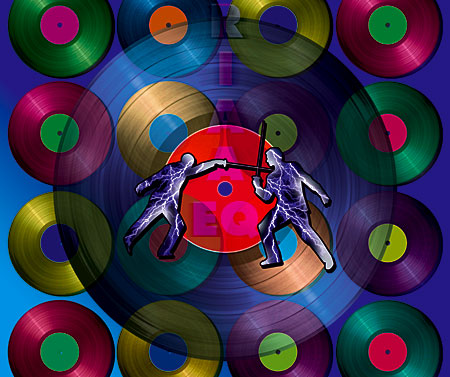
Cut and Thrust: RIAA LP Equalization Page 2
In the summer 1978 issue of Stereo, technical editor Edward J. Foster wrote of the IEC revision: "What point is there in paying literally thousands of dollars for a stereo system capable of response to below 40Hz and then blowing it all on a sloppy subsonic filter?...The record-warp problem will...
and be sure to move on to this:
: https://www.stereophile.com/content/cut-and-thrust-riaa-lp-equalization-neumann-4th-pole-sic
I appreciate his designs but some of his beliefs are completely misguided. He suggests different curves for Blue Note and Prestige records when both were cut by Rudy Van Gelder on the same lathe with the same electronics. He suggests a specific curve for Vanguard records when Vanguard records, being a small label, had its records cut by RCA, and in some cases Columbia Records. I could go on. But the idea that finally you will hear what's on the record that you've never before heard, and that finally it will sound like tape is nothing but marketing hype.
Thanks for the feedback Michael. Of course, it would have been better to suggest that in your experience it is marketing hype. That certainly was not the case for me. Do I agree with every setting recommendation? Of course not. But that doesn't preclude trying others to see if there is a benefit or not on any given LP. In my case, the benefits were significant across a very wide range of LPs.if by the 4th time constant he means the so-called "Neumann pole", please read this

Cut and Thrust: RIAA LP Equalization Page 2
In the summer 1978 issue of Stereo, technical editor Edward J. Foster wrote of the IEC revision: "What point is there in paying literally thousands of dollars for a stereo system capable of response to below 40Hz and then blowing it all on a sloppy subsonic filter?...The record-warp problem will...www.stereophile.com
and be sure to move on to this:
: https://www.stereophile.com/content/cut-and-thrust-riaa-lp-equalization-neumann-4th-pole-sic
I appreciate his designs but some of his beliefs are completely misguided. He suggests different curves for Blue Note and Prestige records when both were cut by Rudy Van Gelder on the same lathe with the same electronics. He suggests a specific curve for Vanguard records when Vanguard records, being a small label, had its records cut by RCA, and in some cases Columbia Records. I could go on. But the idea that finally you will hear what's on the record that you've never before heard, and that finally it will sound like tape is nothing but marketing hype.
The recommendations are using curves as tone controls, the opposite of what’s being claimed, especially regarding the 4th pole. It’s not an opinion! An opinion is that you prefer a different curve than the one that correctly decodes the record. Some things are cut and dried facts and some things are opinions to which everyone is entitled!Thanks for the feedback Michael. Of course, it would have been better to suggest that in your experience it is marketing hype. That certainly was not the case for me. Do I agree with every setting recommendation? Of course not. But that doesn't preclude trying others to see if there is a benefit or not on any given LP. In my case, the benefits were significant across a very wide range of LPs.
| Steve Williams Site Founder | Site Owner | Administrator | Ron Resnick Site Owner | Administrator | Julian (The Fixer) Website Build | Marketing Managersing |

